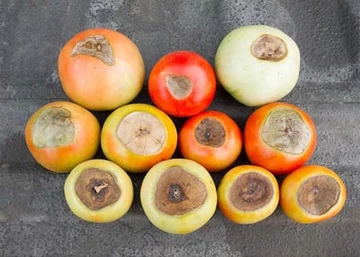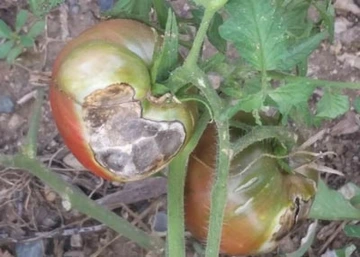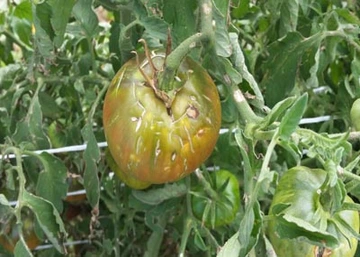Big Plants, No Fruit
Do you have beautiful plants, growing wildly and yet you have no fruit? So, what is going on? Are you fertilizing frequently? That could be the problem. Too much nitrogen will increase the growth of the vines at the expense of the fruit for 3 to 4 weeks after the fertilizer has been applied. Until the nitrogen runs out, the plant uses it to grow vines. Once the nitrogen is used you should start to see flowers and fruit set.
When planting, use a high phosphorus but moderate nitrogen fertilizer and don’t fertilize again until you see flowers and fruit set. It is okay to lightly fertilize monthly. The brand of fertilizer isn’t important. It is the ratio of ingredients and the amount that make the difference. One of the best ways to address this issue is good soil preparation before you even plant. Digging in compost before planting will likely reduce the need for fertilizer during the rest of the gardening season.
Flowers, No Fruit and Blossom Drop
So now you have beautiful plants and flowers but no fruit. Setting of fruit can be affected by a number of factors including temperature, wind, soil, disease, humidity, sunlight and pollinators. One of the biggest factors in Arizona is temperature. Daytime temperatures of 90 degrees cause fruit set to slow down and stops altogether at 94°F, or when nighttime temperatures are over 75°F. On the other end of the scale, temperatures under 55°F stop fruit set also. For us it’s the hot temperatures that have the biggest impact. Hot weather causes the pollen grains to bind together which reduces pollination. Another factor is that many pollinators don’t work in hotter temperatures. Even if fruit develops, high temperatures can cause “whitening”. Whitening causes white, hard areas in the fruit you can see when the tomato is cut open.
There are a few imperfect things that you can do to improve fruit development. Tomatoes are mostly self-pollinators. Basically, the pollen falls on the stigma below it. One way to get the pollen to drop is vibration. In greenhouses with no wind, plants are mechanically shaken. Just go out to your plants and give them a good shake before it gets too hot. Encourage bumblebees in your yard. The vibrations they create work well to get the pollen moving. Another method is to just give the flowers a flick with your fingers. A more high-tech solution is to take your electric toothbrush out to the flowers and vibrate the flower clusters for a few seconds.
Blossom Drop
Hormone preparations that you spray on the flowers to set fruit are available. You can find them in nurseries. They are not perfect. The sprays start the development of fruit, but don’t actually fertilize the flower. The fruit will develop with no seeds or just very small ones. Blossom drop is caused by environmental factors such as extreme temperatures (above 85°F in daytime, below 55°F during the night), poor watering practices, too much light, excessive wind, diseases, too much pruning and excessive fruit set. Humidity can also limit fruit set. Too high humidity (above 70%) is rarely a factor here but too low (below 40%) could be a problem. Fortunately, gardens create their own microclimate and good watering practices will help keep the humidity at an acceptable level. Too high or low soil moisture is another correctible issue. Most vegetables like even watering. They don’t like it too wet nor do they like it too dry. Adjust your watering practices as needed to keep the soil moist but avoid creating a swamp or letting the soil dry out. The worst is to alternate between those two disastrous circumstances. Tomato plants need at least 6 hours of full sun a day. Too much or too little can cause blossom drop. It’s more of problem when growing tomatoes in greenhouses. Diseases and insect infestations can also cause blossom drop. If you see a problem, you just need to address it whether it’s a treatment or removal of the plant.
The Dreaded Tomato Hornworm
There is a lot of gnashing of teeth about hornworms. Some years are worse than others so your tolerance may change from year to year. Just a reminder that caterpillars, like the hornworm, turn into moths and butterflies. In the case of the hornworm they become sphinx moths with about 10 species in Yavapai County. Sphinx moths are great pollinators and are very interesting in their own right. Now after that brief defense of less control than more, hornworms are easily controlled. The simplest is just to pick them off the plant and kill them. Step on them, drown them and chickens love to eat them. You can use the biological insecticide Bacillus thuringiensis (Bt) on them. It is readily available and please read the instructions on how to apply. It is non-toxic and is safe for humans, pets and other wildlife. Look for BT that specifically targets hornworms.
Curly Top Virus
This is very common in Yavapai County and can affect many different crops. It is a viral disease that is hard to manage. The plants contract the disease from an insect, the beet leafhopper. The leafhopper picks up the virus in early spring from weeds like mustard and Russian thistle. Leafhoppers feed by piercing the plant and in the process spread the virus. The infected plant leaves start to pucker and become stunted, curl and roll upward while the main petiole down the center of the leaf curls downward. Leaves turn yellow and leathery and the veins turn purple. Leafhoppers are good fliers and difficult to keep out of the garden. While tomatoes are not the favorite food of leafhoppers they will feed on them. The best way to prevent the leafhopper from feeding is to prevent access to the plants. Use row covers from early spring to mid-season. Make sure the cover is secured to the ground.
There is no cure and no chemical that can be applied that will cure the disease. Once a plant starts showing symptoms, remove the plant and throw it away; it will eventually die. You may replant in the same spot.
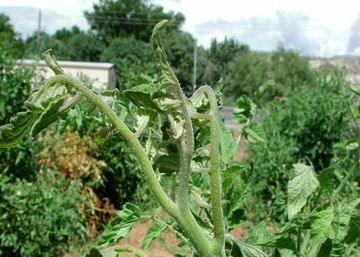
Cat facing
Catfacing is the malformation and scarring of fruit particularly on the blossom end. The fruit is puckered with swollen protuberances and can have cavities that go into the flesh. Incomplete pollination or physical damage to the blossom can cause catfacing. It can also be caused by extreme heat or cold weather (below 58°F at night), drought (good watering practices will solve it), high nitrogen levels or herbicide spray. Some varieties are more susceptible to catfacing than others.
Photo: Mississippi State University
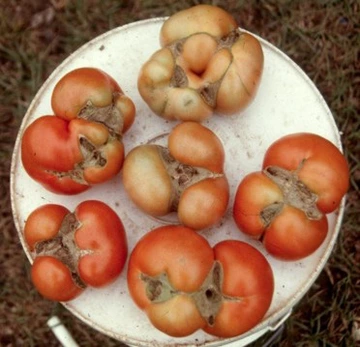
Cracking
Cracking occurs when there is rapid change in soil moisture levels. The fruit expands faster than the skin can grow. They can be vertical cracks or circular cracks around the top. If the tomato is green when the cracking occurs the fruit will likely rot before it ripens. These tomatoes can be picked and allowed to ripen off the vine. Some varieties are more susceptible but make sure you are providing even watering. Cracking most often occurs during the monsoon season if we have heavy rains. If it rains hard in your garden, wait before you water again. Even moisture is what you are trying to achieve.
Photo: Lee Atonna
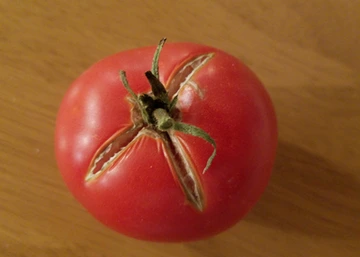
Zippering
Zippering is brown tissue resembling a zipper, usually running from the stem end to the blossom end. It is caused by abnormalities during early flower development. It is not a common problem and if you have problems with it try a different variety, some varieties are better than others when it comes to zippering.
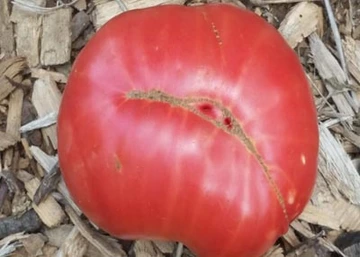
Blossom End Rot
It mostly affects tomatoes, peppers and watermelons. It shows as light tan to nearly black lesions on the fruit on the blossom end. The spot gets larger as the fruit matures. It can be caused by moisture stress, too much nitrogen, magnesium, potassium or sodium fertilization and high salt levels in soil or water. It is thought that there is not enough calcium available to developing fruit. Other factors may be extreme heat or cold, over-fertilization and acid soils. Tomatoes with blossom end rot usually don’t ripen well. Blossom end rot can often affect the first tomatoes of the season; as the weather and soil warms the problem disappears. Good watering and soil management practices should help prevent the problem. Additions of gypsum and calcium sprays are sometimes recommended but aren’t really necessary in Arizona soils. Good cultural practices and patience seem to be the best choice. Epsom salts is not a remedy to prevent blossom end rot.
Photo: Utah State
